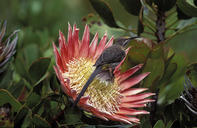
Name
Cape sugarbird - Promerops cafer
Cape Sugarbird Appearance
One of only two sugarbirds found in South Africa, the Cape sugarbird is easy to recognise. They are a buffy-grey colour, with a yellow vent (under tail) and a long flowing tail. The bill is long and decurved. A conspicuous malar strip is visible.
The male is around 40 cm in length and the female, with the shorter tail, is around 30 cm in length. The female has a paler breast than the male.
Diet
The Cape sugarbird is a specialist nectar feeder, specialising in feeding on proteas. The sugarbird has a long, brush-tipped tongue for nectar feeding. The Cape sugarbird will also eat insects.
Cape Sugarbird Breeding
During the breeding season, the male Cape sugarbird will make territorial display flights, where he will clatter his tail and frip his wings making a distinct audible sound. They are monogamous, the nest is an untidy cup shape made of twigs and plant matter. One or two eggs are laid and incubated by the female for around 21 days. The chicks fledge around 18 days later and become independent about 21 days later.
Cape Sugarbird Behaviour
The Cape sugarbird is an important pollinator for many fynbos plants and will visit a couple of hundred plants in a day.
The male is very territorial and is often seen sitting at the top of a protea bush, used as a lookout to defend his territory.
Threats
None.
Cape Sugarbird Distribution and Habitat
Cape sugarbird are endemic to South Africa and are restricted to the fynbos biome , between the Cederberg Mountains and the Buffalo River in the Eastern Cape. The Cape sugarbird’s distribution is dependent on the Protea flower, used both for food and nesting.